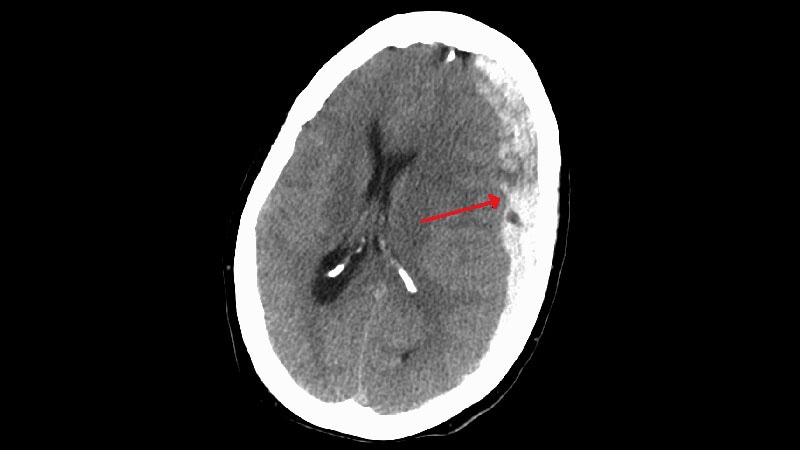Embolization Reduces Subdural Hematoma Surgery Need
Alapfogalmak
Embolization procedures significantly reduce the need for surgery in patients with subdural hematomas, offering a breakthrough treatment option.
Kivonat
The treatment of subdural hematomas has seen a significant advancement with the introduction of embolization procedures. Three randomized controlled trials, EMBOLISE, MAGIC-MT, and STEM, showcased the benefits of embolization in reducing the need for surgery and recurrence rates in patients with subdural hematomas. The trials utilized different embolization products, such as Onyx and Squid, to deliver the treatment. Embolization has emerged as a promising alternative to traditional surgical methods, offering improved outcomes and safety profiles for patients with subdural hematomas.
EMBOLISE Trial:
MMA embolization with the Onyx product led to a significant reduction in the need for repeat surgical drainage of subdural hematomas.
The embolization group showed lower rates of hematoma recurrence/progression and neurologic deterioration compared to the control group.
Safety outcomes were favorable with minimal serious adverse events related to the embolization procedure.
MAGIC-MT Trial:
The trial demonstrated that embolization was superior to usual care alone in reducing hematoma recurrence or progression.
Functional outcomes were similar in embolization and control patients, with most patients showing good recovery.
Serious adverse events were fewer in patients receiving embolization.
STEM Trial:
Embolization therapy significantly reduced treatment failure rates in patients with chronic subdural hematomas.
The procedure was beneficial for both surgical and nonsurgical patient populations, offering a promising treatment option.
Safety outcomes were comparable between the standard management and embolization groups.
Subdural Hematoma Embolization Success Cuts Surgery Need
Statisztikák
"The primary endpoint was the rate of hematoma recurrence/progression requiring repeat surgical drainage within 90 days."
"This occurred in 4.1% of the embolization group vs 11.3% of the control group."
"Serious adverse events related to the embolization procedure occurred in 2% of patients."
"The primary outcome was symptomatic subdural hematoma recurrence or progression within 90 days."
"This occurred in 7.2% of the embolization group vs 12.2% of the control group."
"The primary endpoint occurred in 39.2% of the standard management groups vs 15.2% of the group who received standard management plus embolization therapy."
Idézetek
"All these three trials are positive. They are essentially showing the same thing and provide strong class 1 level evidence that endovascular treatment for subdural hematoma is strongly beneficial." - Tudor Jovin, MD
"Essentially, we are gluing shut the artery that feeds the dura." - Jason Davies, MD
"These data show that this embolization procedure should enable many patients with subdural hematoma to avoid having surgery altogether." - Adam Arthur, MD
Főbb Kivonatok
by : www.medscape.com 02-13-2024
https://www.medscape.com/viewarticle/subdural-hematoma-embolization-success-cuts-surgery-need-2024a100031u
Mélyebb kérdések
How might the introduction of embolization procedures impact the current standard of care for subdural hematoma treatment?
The introduction of embolization procedures for subdural hematomas is poised to significantly impact the current standard of care for this condition. Traditionally, the treatment of subdural hematomas involved surgery to remove the fluid and breakdown products from the dural space, which can be invasive and come with various complications, especially in elderly patients. The new embolization procedures offer a less invasive alternative that has shown promising results in reducing the need for surgery and the rates of recurrence. By delivering embolization products via transcatheter procedures to block the arteries supplying blood to the dura, these procedures effectively reduce the need for repeat surgical drainage of the hematoma. This shift towards embolization procedures is likely to change the treatment landscape for subdural hematomas, offering patients a safer and more effective option compared to traditional surgical interventions.
What potential challenges or limitations could arise with the widespread adoption of embolization for subdural hematomas?
While the introduction of embolization procedures for subdural hematomas brings about significant benefits, there are potential challenges and limitations that could arise with their widespread adoption. One key challenge is the need for specialized training and expertise in performing these endovascular procedures. Not all healthcare facilities may have the necessary resources or personnel trained in embolization techniques, which could limit access to this treatment option for some patients. Additionally, there may be concerns regarding the cost-effectiveness of embolization procedures compared to traditional surgical methods, which could impact their adoption in certain healthcare settings. Furthermore, as with any new medical intervention, there may be unforeseen complications or long-term effects associated with embolization that need to be carefully monitored and studied to ensure patient safety and efficacy.
How can advancements in embolization procedures for subdural hematomas influence the development of treatments for other neurological conditions?
The advancements in embolization procedures for subdural hematomas have the potential to influence the development of treatments for other neurological conditions in several ways. Firstly, the success of embolization in reducing the need for surgery and improving patient outcomes in subdural hematomas could inspire researchers and clinicians to explore similar endovascular approaches for other neurovascular conditions. This could lead to the development of new minimally invasive techniques for treating a wide range of neurological disorders, offering patients less invasive treatment options with potentially better outcomes. Additionally, the positive results seen with embolization procedures may encourage further research and investment in endovascular technologies for neurological conditions, driving innovation and advancements in the field. Overall, the success of embolization procedures for subdural hematomas could pave the way for transformative treatments in neurology and neurosurgery, benefiting patients with various neurological disorders.
0
